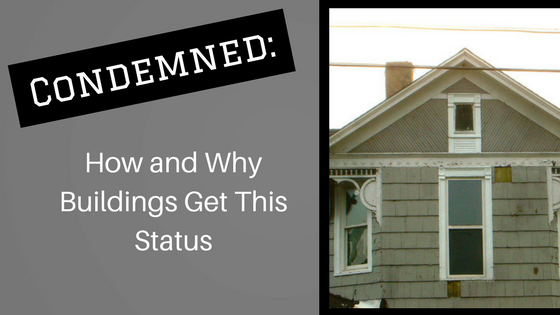Condemned — just the sound of the word seems like it’s bad news. Although most condemned buildings are often done so for unsafe or unsanitary reasons, that is not always the case because condemned buildings may also help the environment and community.
In some cases, buildings are condemned because the property is in such a state of dilapidation that repairs cannot be made while people are living or conducting business on the property. In other cases, buildings can be condemned if private property needs to be converted to public use, such as creating additional housing in times of crises.
If you’re curious to see how and why buildings are condemned, take a look below!
Reasons to Condemn a Building
There are many reasons buildings can be condemned, but here are five main reasons.
- The building is damaged beyond repair. Say that a building was gutted by a fire or extensively flooded by a hurricane. Damage to this extent will make repairs almost impossible — especially if the structural integrity of the building is nowhere near up to code.
- The building poses a health hazard to its occupants. Due to contamination or infestations, a building may be condemned if the building is too unsafe to be cleaned. A few examples of this issue may be black mold, because it causes respiratory and other health problems, and long-term parasite infestations if the issue has been attended to but shows no signs of stopping.
- The building has poor construction. Usually, the only way buildings can be condemned for this matter is if the building’s materials — most notably asbestos — have been banned by the government. In addition, the buildings’ original construction may not have used key pieces in the building, such as foundation and support beams.
- The building hasn’t had any occupants in quite a long time. Has the building been vacant for years and fallen into a state of such disrepair that it’s become an eyesore and embarrassment to the community? This may be a reason to condemn the building on behalf of the community.
- The government can take private property to turn it into public use. Sometimes local governments can seize private property for building projects. This often occurs when the government needs to widen roads due to too much traffic congestion or if there is a severe housing shortage and the seized land is turned into apartment buildings.
How Buildings are Condemned
If the property is condemned for the first four reasons listed above…
- A housing inspector or the Department of Health will inspect the premises, then determine that all or a part of the building unfit to live or conduct business in.
- The housing inspector or the Department of Health will provide the property owner with citations and notices to arrange for repairs to the property.
- If repairs are not made, the Department of Health will order that the premises must be vacated, and in some cases, demolished.
But if the government is seizing the land for public use…
- The government will offer the property owner an appraisal of how much the property is worth and will offer a payout based on the appraisal.
- If the property owner will not accept the appraisal, then the government has a right to file legal action to seize the property.
